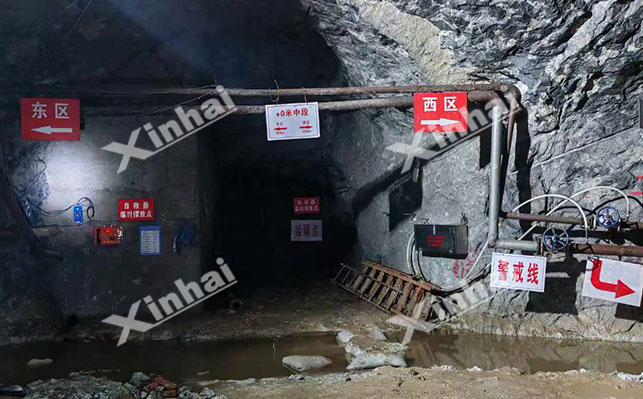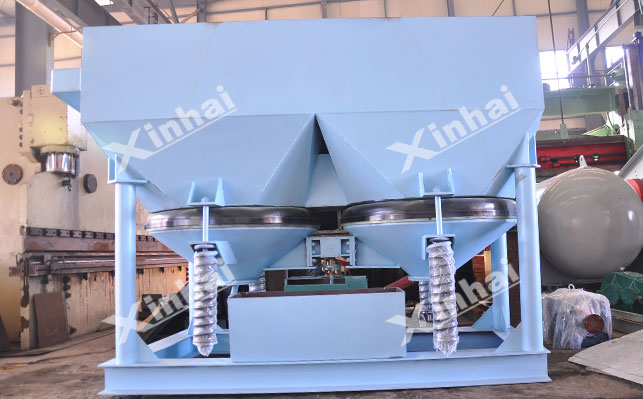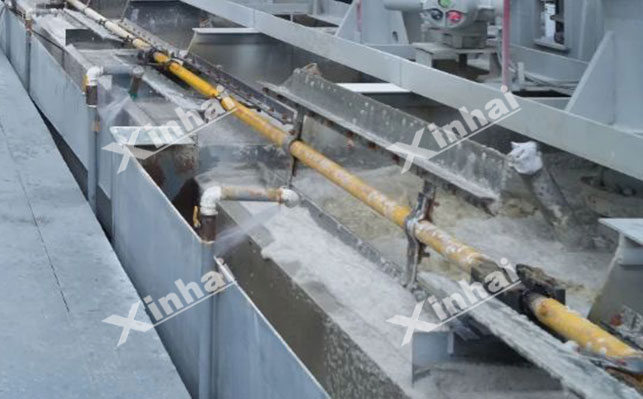
15311826613
Click to add WeChatMica is a layered hydrated aluminosilicate mineral containing multiple elements such as potassium, aluminum, magnesium, iron, and lithium. It is widely used in various industrial fields, ranging from an insulating foundation in the electrical and electronic industries to a reinforcing additive in plastics and rubber, and even to a core raw material for pearlescent pigments. Mica is everywhere. With the development of technology and the progress of industry, the demand for mica has been continuously rising. How to efficiently, safely and environmentally friendly mine and select mica ores has become the focus of research in the mining field. This article provides a detailed introduction to mica mining and mica beneficiation.
The mining methods for mica ore should be selected in combination with the type of deposit, occurrence state and ore characteristics. The main mining principle is to "protect the integrity of mica crystals", and priority should be given to mining methods that cause less disturbance to the ore. At present, there are mainly two categories: open-pit mining and underground mining.

Open-pit mining is suitable for mica deposits with shallow burial, exposed ore bodies on the surface or thin overburden, especially the shallow ore bodies of pegmatite-type mica deposits. The process is as follows:
Stripping the overburden: Use bulldozers, excavators, etc. to remove the topsoil, weathering layer, etc. of the ore body to expose the mica ore body beneath. During the peeling process, if the covering layer contains a small amount of mica, simple methods such as screening can be adopted for recovery to enhance the utilization rate of resources.
Ore body mining: For pegmatite ore bodies with good integrity, shallow hole blasting is adopted. The blasting parameters must be strictly controlled to prevent mica sheets from breaking due to blasting vibration. For loose or severely weathered ore bodies, excavators and loaders are directly used for mining, combined with manual picking. Large mica sheets with a diameter of ≥4cm are selected first to ensure the recovery of high-value products.
Ore processing: After mining, the ore is first screened and classified to remove waste rocks, and then the mica-containing ore is transported to the concentrator for further processing. Open-pit mining areas should be equipped with drainage and interception systems to prevent the collapse of mine piles caused by rainwater erosion.
Underground mining is mostly suitable for mica deposits that are buried deep (with overburden thickness > 20m), have complex ore body shapes (such as vein-shaped or lens-shaped), or where excavation is not allowed on the surface. There are many methods of underground mining, which can include the following types:
Shallow hole retention method: Suitable for mica deposits with a thickness of 1-5m, an inclination Angle greater than 60°, and stable surrounding rock (such as pegmatite vein type mica deposits). This method mainly involves layer-by-layer mining from the bottom of the ore body upwards, with each layer's height set at 2 to 3 meters. Shallow hole blasting is utilized, and the ore falls off at a depth of 1.5 to 2 meters. The ore slides down to the bottom ore extraction point by its own weight. During the mining process, 10% to 15% of the ore pillars should be reserved to support the roof, maintaining the stability of the stope and facilitating the subsequent recovery of mica from the ore pillars. Manual picking should be carried out promptly after blasting to prevent mechanical operations from causing mica breakage.
The Fangzhu method: It is suitable for mica deposits with a thickness of 3 to 10 meters, an inclination Angle of less than 30°, and moderately stable surrounding rock (compressive strength of 30 to 60MPa). The ore body is divided into the ore-forming chamber and the pillar. The width of the ore-forming chamber is generally 5 to 8 meters, and the diameter of the pillar is 3 to 5 meters. The two are arranged at intervals. Rock drills are used to blast the ore in the mine room, and loaders cooperate with small mine cars to complete the ore discharge operation. This method has a small exposed roof area, with a single mine room usually less than 500 square meters. It is highly safe and can better adapt to the recovery of mica in horizontal or gently inclined ore bodies.
Filling mining method: It is suitable for situations where the ore body is deeply buried, the surrounding rock is fragmented (compressive strength < 30MPa), or the surface needs strict protection. The step-by-step mining method is adopted. After each section of mining is completed, the mined-out area is immediately filled with waste rock, tailings or cementing materials, which can effectively control ground pressure and reduce the damage to mica caused by roof collapse.
The above are several common mining methods for mica ore. Generally, open-pit mining is used for shallow ore bodies, shallow hole retention method or column method is adopted for deep and stable ore bodies, and filling method is used under complex conditions.
The beneficiation method for mica ore should be selected comprehensively based on the properties of the ore and the requirements of the target product. No matter which method is used, the main purpose is to achieve the effective separation of mica and gangue minerals. The common methods for mica beneficiation mainly include hand separation, gravity separation and flotation.
Hand selection is an ancient and traditional method. For mica with intact crystals and large sheet diameters in pegmatite-type mica ores, separation can be directly achieved through manual picking. After the ore is mined, it undergoes crushing and screening. Manually, the qualified screened materials are picked out to extract large pieces of mica that meet the specifications.

Gravity separation mainly utilizes the density difference between mica and gangue minerals, achieving separation through centrifugal force or reciprocating gravitational motion, etc. However, before gravity separation, advanced pretreatment is required to magnify the density difference between minerals. After the raw ore is crushed and ground, it is first stratified by a vibrating screen to separate minerals of different particle sizes according to their grades. Then, the appropriate gravity separation is selected based on the particle size of the minerals.
Shaking table: Suitable for particle size of 1 to 3mm. Through the inclined water flow and the vibration of the bed surface, mica is enriched in the fine mining area of the bed surface.
Jigging machine: Suitable for coarse-grained grades ranging from 3 to 10mm. It utilizes vertical alternating water flow. Mica, due to its flaky form, has high resistance in water and is easily carried to the upper layer of concentrate by the water flow, while gangways sink to become tailings.
Spiral chute: Suitable for -1mm fine particle size. Through the combined action of centrifugal force and gravity, mica is retained and enriched on the inner side of the chute.
When mica is closely interwoven with gangue or other methods cannot achieve effective recovery, flotation is usually adopted for enrichment. Flotation is a process that takes advantage of the differences in surface properties between mica minerals and other minerals. By introducing chemicals, the surface properties of the minerals are altered to make them hydrophobic or hydrophilic. Hydrophilic substances adhere to the instant noodles and float up, thereby achieving effective separation. The commonly used chemicals are as follows:

Collector: Amine agent, mainly through electrostatic adsorption, adheres to the surface of mica to make it hydrophobic.
Adjustment agent: Sulfuric acid or hydrochloric acid, to adjust the pH of the pulp to acidic (3-5) and enhance its selectivity;
Inhibitor: Water glass, which inhibits the floatability of gangue minerals such as quartz and feldspar.
Pegmatite-type mica deposits often contain mica with larger crystals, are sparsely distributed, and coexist with gangue minerals such as quartz and feldspar. The ore body has good integrity and a large scale.
Mining: The commonly used methods are open-pit mining (shallow) and shallow hole retention (deep). Priority is given to protecting large pieces of mica with intact crystals. During blasting, the process of "drilling more holes and loading less charge" is adopted.
Mineral processing: The commonly used method is hand separation combined with gravity separation. First, large pieces of mica are manually sorted out by hand. The remaining slag is crushed and classified, and then the crushed mica is recycled by a shaker for gravity separation, achieving the goal of "selecting large pieces first and effectively recovering crushed mica".
Sedimentary mica deposits are mostly gently inclined thin-layer ore bodies. Mica is fine-grained and embedded (with sheet diameters mostly less than 1cm), closely coexisting with minerals such as clay and quartz, and the boundary between the ore and the surrounding rock is relatively indistinct.
Mining: It is mostly suitable for the cave-column method of mining. During mining, mechanical crushing should be avoided to prevent the mica sheets from cracking.
Beneficiation: The flotation process is mainly adopted, with dodecylamine as the collector. The pH is adjusted to 3-5, and auxiliary classification and desliming are used to recover fine-grained mica. 3. Mining and selection of weathered and residual mica ore
The weathered and residual mica ore is loose, with a high degree of separation between mica and gangue, mixed flake sizes, thin overburden, and is mostly distributed on the surface or in shallow areas.
Mining: Suitable for open-pit mining + manual picking, no blasting required, direct excavation followed by screening.
Mineral processing: The commonly used method is screening combined with air separation. For qualified materials after screening, mica and gangue are separated by taking advantage of the difference in air resistance. In water-scarce areas, jigging gravity separation can be adopted as an auxiliary operation.
Xinhai Mining Equipment has rich experience in mica mining and beneficiation technology and holds the first-class qualification for general contracting of mine engineering construction. It can provide services covering all aspects from E, P, C, M to O for various types of mica mines That is, mine technology consultation and experimental research and design, complete sets of equipment manufacturing and procurement, engineering construction, installation, commissioning and delivery, mine construction management, mine production operation management and services.
Xinhai is committed to providing one-stop, tailor-made overall services for each mine's beneficiation plant, and determines the project's valuation, investment, cost and benefits through collaborative cooperation.